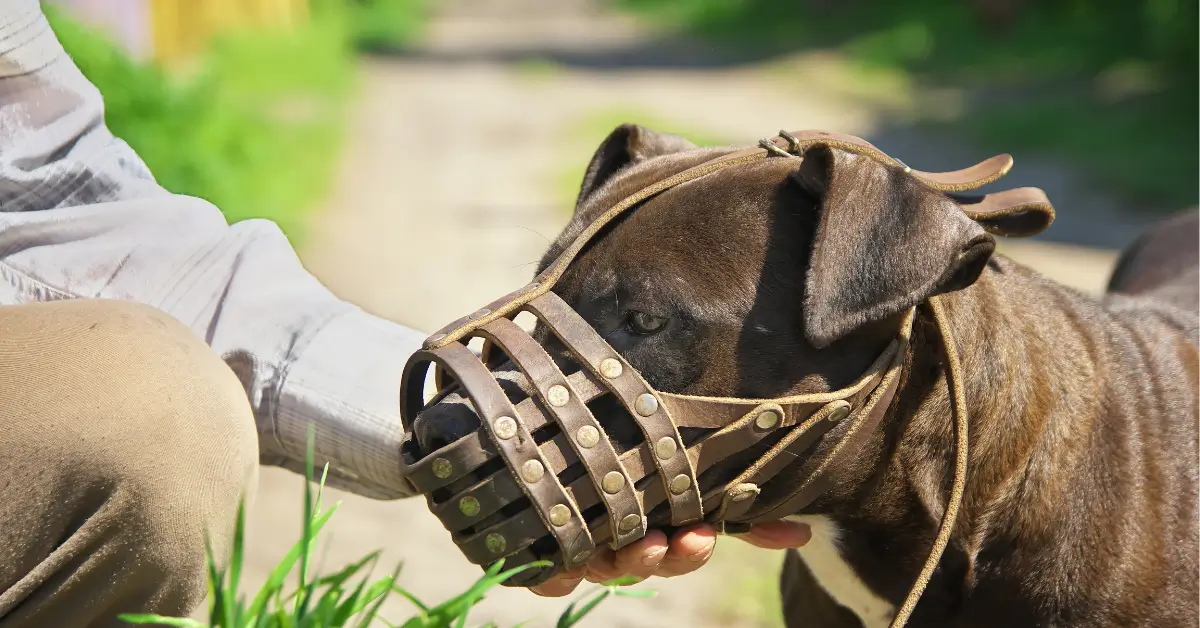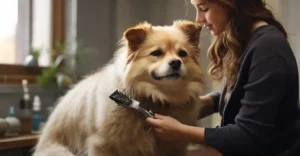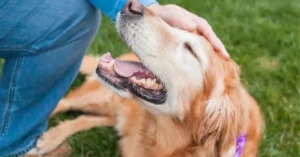Muzzling an aggressive dog is a crucial step in ensuring the safety of others and the dog itself. This guide provides a gentle approach to selecting, fitting, and training your dog to wear a muzzle, incorporating positive reinforcement and care to make the experience as stress-free as possible.
The Importance of Muzzling for Your Dog’s Safety
Muzzling is essential not only for moments when your dog might be in pain or fear but also as a preventive measure. Think of a muzzle as a seatbelt for your dog—it’s there to prevent problems. Just like we don’t plan on using our seatbelt in an accident but are grateful for its protection, the same goes for a muzzle. It’s a way to ensure safety during unforeseen situations or behavioral challenges (Vca).
Exploring Muzzle Options for Your Aggressive Pooch
Navigating the World of Basket Muzzles
Basket muzzles, recommended by the AKC (American Kennel Club), are a humane choice for many dogs, allowing them to pant, drink, and even enjoy treats through the bars. This design makes them comfortable for your dog and suitable for wearing over more extended periods. Despite looking a bit scary, they help prevent bites without stopping your dog from being able to bark, making them less intimidating once you get used to them. It’s important to train your dog step by step to stick their nose into the basket muzzle, using treats like chicken to make the process easier. With patience and the help of a professional, if needed, getting your dog to wear a muzzle securely becomes a much smoother procedure.
Understanding the Role of Soft Muzzles
Soft muzzles are usually made from fabric or leather and are designed to keep your dog’s mouth closed. This makes them less comfortable and not as safe as basket muzzles, especially since they limit your dog’s natural ability to pant, which is crucial for cooling down. Therefore, they should only be used for short periods and never in hot weather to avoid causing your pet fear and anxiety. Training your dog to accept a soft muzzle may require you to be extra patient, using step-by-step instructions and giving treats to ensure the muzzle is properly and comfortably fitted. Remember, the right muzzle can help manage reactive behavior safely, with the ultimate goal of long-term comfort and safety for your dog.
Selecting the Perfect Muzzle for Your Canine Companion
Choosing the right muzzle involves understanding the fit and ensuring it is appropriate for your dog’s size and breed. Muzzles need to be snug enough to stay on but not so tight as to be uncomfortable. There should be enough room for your dog to pant and, in the case of basket muzzles, to receive treats (K9Aggression).
Ensuring a Snug and Comfortable Muzzle Fit
Proper fit is crucial. Use a string to measure your dog’s snout and compare it to a tape measure to ensure you select the correct size. A well-fitting muzzle will prevent it from being too tight or too loose, which could cause discomfort or allow your dog to remove it (K9Aggression) (Dogs Naturally).
Gentle Steps to Muzzle Training Your Dog
Making the First Introduction to the Muzzle
Introduce the muzzle in a non-threatening way, allowing your dog to sniff and explore it without forcing it on them. Pair the muzzle with treats to build a positive association, gradually moving to feeding treats through the muzzle to increase comfort.
Building Up Comfort and Extending Wear Time
Start with short sessions, gradually increasing the time your dog wears the muzzle. Use treats to encourage them to keep the muzzle on, slowly extending the duration from seconds to minutes. Be patient and consistent, rewarding calm behavior and not fussing (Off Leash K9 Training Lehigh Valley PA).
Muzzle training is about creating a positive and safe experience for your dog. By following these steps and maintaining patience, your dog can learn to wear a muzzle comfortably, ensuring their safety and the safety of others around them.
Keeping Your Dog Safe: Muzzle Safety and Care
Once your dog is comfortable with the muzzle, ensuring their ongoing comfort and safety becomes the next priority. The muzzle should be secure but not overly tight, allowing your dog to pant and drink water. This is crucial for preventing overheating and ensuring your pet remains hydrated. Always supervise your dog while they’re wearing a muzzle to prevent them from getting tangled or stuck, which could cause panic or injury (Doggie Connect).
Overcoming Muzzle Training Hurdles and FAQs
Training a dog to wear a muzzle can come with its set of challenges. It’s important to remember that patience and consistency are key. If your dog shows signs of distress or attempts to remove the muzzle, revisit earlier training steps and shorten the duration of wear. Positive reinforcement, through treats and praise, should be a continuous part of the process to help your dog associate the muzzle with positive experiences. Address any signs of discomfort or irritation by adjusting the fit or consulting with a professional if necessary.
Ensuring your dog is comfortable and accepting of the muzzle involves a gradual and gentle approach, focusing on positive reinforcement and the well-being of your pet. By carefully selecting the right type of muzzle, fitting it correctly, and patiently training your dog, you can make wearing a muzzle a stress-free experience for both you and your dog. This not only enhances safety but also promotes a positive relationship between you and your canine companion.
In this guide, we’ve outlined a compassionate and effective approach to muzzle training that prioritizes your dog’s comfort and safety. Remember, the goal of muzzle training is not to punish but to protect. With the right mindset, techniques, and tools, your dog can learn to wear a muzzle comfortably, ensuring their safety and the safety of those around them.
Q: How do I put a muzzle on my aggressive dog?
A: To put a muzzle on your dog, first get your dog accustomed to the muzzle by allowing them to sniff it and associating it with positive experiences like treats. Then, gently place the muzzle over your dog’s nose and secure the strap behind their ears. Make sure the muzzle is properly fitted and comfortable for your dog.
Q: What is the best way to train my dog to wear a muzzle?
A: The best way to train your dog to wear a muzzle is to introduce it gradually in short sessions. Repeat the process regularly, gradually increasing the time your dog wears the muzzle. Use positive reinforcement techniques like giving treats to create a positive association with the muzzle.
Q: Why should I consider seeking the help of a professional dog trainer or behaviorist for muzzle training?
A: Seeking the help of a professional dog trainer or behaviorist is recommended for aggressive dogs or those showing reactive behavior when wearing a muzzle. These experts can provide step-by-step instructions tailored to your dog’s needs and ensure a safe and effective training process.
Q: How can I ensure that the muzzle is properly secured on my dog?
A: To ensure the muzzle is properly secured, make sure it fits snugly around your dog’s nose without being too tight or too loose. Follow the manufacturer’s instructions for securing the muzzle and regularly check for any signs of discomfort or rubbing.
Q: What should I do if my dog is uncomfortable while wearing the muzzle?
A: If your dog is uncomfortable while wearing the muzzle, take it off immediately and assess the fit. Adjust the muzzle if needed and try again. It’s essential to make sure the muzzle is comfortable and does not cause any distress to your dog.
Q: Can all dogs benefit from wearing a muzzle?
A: While muzzles can be helpful for many dogs in various situations, they are particularly recommended for aggressive or reactive dogs. Muzzles can prevent biting or barking and help manage your dog’s behavior in stressful situations.
Q: How can I help my dog get used to wearing a muzzle in the long term?
A: To help your dog get used to wearing a muzzle in the long term, start with short training sessions and gradually increase the duration. Use positive reinforcement techniques and make wearing the muzzle a positive experience for your dog by associating it with treats or playtime.



